Aditya Kane
Person Recognition at Altitude and Range: Fusion of Face, Body Shape and Gait
May 07, 2025Abstract:We address the problem of whole-body person recognition in unconstrained environments. This problem arises in surveillance scenarios such as those in the IARPA Biometric Recognition and Identification at Altitude and Range (BRIAR) program, where biometric data is captured at long standoff distances, elevated viewing angles, and under adverse atmospheric conditions (e.g., turbulence and high wind velocity). To this end, we propose FarSight, a unified end-to-end system for person recognition that integrates complementary biometric cues across face, gait, and body shape modalities. FarSight incorporates novel algorithms across four core modules: multi-subject detection and tracking, recognition-aware video restoration, modality-specific biometric feature encoding, and quality-guided multi-modal fusion. These components are designed to work cohesively under degraded image conditions, large pose and scale variations, and cross-domain gaps. Extensive experiments on the BRIAR dataset, one of the most comprehensive benchmarks for long-range, multi-modal biometric recognition, demonstrate the effectiveness of FarSight. Compared to our preliminary system, this system achieves a 34.1% absolute gain in 1:1 verification accuracy (TAR@0.1% FAR), a 17.8% increase in closed-set identification (Rank-20), and a 34.3% reduction in open-set identification errors (FNIR@1% FPIR). Furthermore, FarSight was evaluated in the 2025 NIST RTE Face in Video Evaluation (FIVE), which conducts standardized face recognition testing on the BRIAR dataset. These results establish FarSight as a state-of-the-art solution for operational biometric recognition in challenging real-world conditions.
Generalized Neighborhood Attention: Multi-dimensional Sparse Attention at the Speed of Light
Apr 23, 2025Abstract:Many sparse attention mechanisms such as Neighborhood Attention have typically failed to consistently deliver speedup over the self attention baseline. This is largely due to the level of complexity in attention infrastructure, and the rapid evolution of AI hardware architecture. At the same time, many state-of-the-art foundational models, particularly in computer vision, are heavily bound by attention, and need reliable sparsity to escape the O(n^2) complexity. In this paper, we study a class of promising sparse attention mechanisms that focus on locality, and aim to develop a better analytical model of their performance improvements. We first introduce Generalized Neighborhood Attention (GNA), which can describe sliding window, strided sliding window, and blocked attention. We then consider possible design choices in implementing these approaches, and create a simulator that can provide much more realistic speedup upper bounds for any given setting. Finally, we implement GNA on top of a state-of-the-art fused multi-headed attention (FMHA) kernel designed for the NVIDIA Blackwell architecture in CUTLASS. Our implementation can fully realize the maximum speedup theoretically possible in many perfectly block-sparse cases, and achieves an effective utilization of 1.3 petaFLOPs/second in FP16. In addition, we plug various GNA configurations into off-the-shelf generative models, such as Cosmos-7B, HunyuanVideo, and FLUX, and show that it can deliver 28% to 46% end-to-end speedup on B200 without any fine-tuning. We will open source our simulator and Blackwell kernels directly through the NATTEN project.
SenTest: Evaluating Robustness of Sentence Encoders
Nov 29, 2023

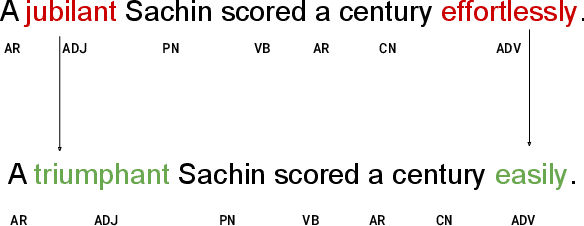

Abstract:Contrastive learning has proven to be an effective method for pre-training models using weakly labeled data in the vision domain. Sentence transformers are the NLP counterparts to this architecture, and have been growing in popularity due to their rich and effective sentence representations. Having effective sentence representations is paramount in multiple tasks, such as information retrieval, retrieval augmented generation (RAG), and sentence comparison. Keeping in mind the deployability factor of transformers, evaluating the robustness of sentence transformers is of utmost importance. This work focuses on evaluating the robustness of the sentence encoders. We employ several adversarial attacks to evaluate its robustness. This system uses character-level attacks in the form of random character substitution, word-level attacks in the form of synonym replacement, and sentence-level attacks in the form of intra-sentence word order shuffling. The results of the experiments strongly undermine the robustness of sentence encoders. The models produce significantly different predictions as well as embeddings on perturbed datasets. The accuracy of the models can fall up to 15 percent on perturbed datasets as compared to unperturbed datasets. Furthermore, the experiments demonstrate that these embeddings does capture the semantic and syntactic structure (sentence order) of sentences. However, existing supervised classification strategies fail to leverage this information, and merely function as n-gram detectors.
Task Arithmetic with LoRA for Continual Learning
Nov 04, 2023Abstract:Continual learning refers to the problem where the training data is available in sequential chunks, termed "tasks". The majority of progress in continual learning has been stunted by the problem of catastrophic forgetting, which is caused by sequential training of the model on streams of data. Moreover, it becomes computationally expensive to sequentially train large models multiple times. To mitigate both of these problems at once, we propose a novel method to continually train transformer-based vision models using low-rank adaptation and task arithmetic. Our method completely bypasses the problem of catastrophic forgetting, as well as reducing the computational requirement for training models on each task. When aided with a small memory of 10 samples per class, our method achieves performance close to full-set finetuning. We present rigorous ablations to support the prowess of our method.
My Boli: Code-mixed Marathi-English Corpora, Pretrained Language Models and Evaluation Benchmarks
Jun 24, 2023Abstract:The research on code-mixed data is limited due to the unavailability of dedicated code-mixed datasets and pre-trained language models. In this work, we focus on the low-resource Indian language Marathi which lacks any prior work in code-mixing. We present L3Cube-MeCorpus, a large code-mixed Marathi-English (Mr-En) corpus with 5 million tweets for pretraining. We also release L3Cube-MeBERT and MeRoBERTa, code-mixed BERT-based transformer models pre-trained on MeCorpus. Furthermore, for benchmarking, we present three supervised datasets MeHate, MeSent, and MeLID for downstream tasks like code-mixed Mr-En hate speech detection, sentiment analysis, and language identification respectively. These evaluation datasets individually consist of manually annotated \url{~}12,000 Marathi-English code-mixed tweets. Ablations show that the models trained on this novel corpus significantly outperform the existing state-of-the-art BERT models. This is the first work that presents artifacts for code-mixed Marathi research. All datasets and models are publicly released at https://github.com/l3cube-pune/MarathiNLP .
Two-stage Pipeline for Multilingual Dialect Detection
Mar 06, 2023Abstract:Dialect Identification is a crucial task for localizing various Large Language Models. This paper outlines our approach to the VarDial 2023 shared task. Here we have to identify three or two dialects from three languages each which results in a 9-way classification for Track-1 and 6-way classification for Track-2 respectively. Our proposed approach consists of a two-stage system and outperforms other participants' systems and previous works in this domain. We achieve a score of 58.54% for Track-1 and 85.61% for Track-2. Our codebase is available publicly (https://github.com/ankit-vaidya19/EACL_VarDial2023).
A Twitter BERT Approach for Offensive Language Detection in Marathi
Dec 20, 2022
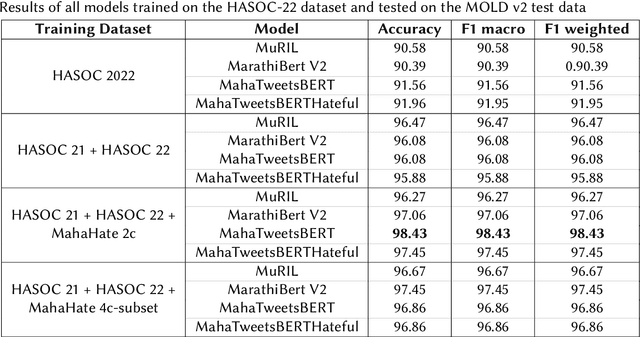
Abstract:Automated offensive language detection is essential in combating the spread of hate speech, particularly in social media. This paper describes our work on Offensive Language Identification in low resource Indic language Marathi. The problem is formulated as a text classification task to identify a tweet as offensive or non-offensive. We evaluate different mono-lingual and multi-lingual BERT models on this classification task, focusing on BERT models pre-trained with social media datasets. We compare the performance of MuRIL, MahaTweetBERT, MahaTweetBERT-Hateful, and MahaBERT on the HASOC 2022 test set. We also explore external data augmentation from other existing Marathi hate speech corpus HASOC 2021 and L3Cube-MahaHate. The MahaTweetBERT, a BERT model, pre-trained on Marathi tweets when fine-tuned on the combined dataset (HASOC 2021 + HASOC 2022 + MahaHate), outperforms all models with an F1 score of 98.43 on the HASOC 2022 test set. With this, we also provide a new state-of-the-art result on HASOC 2022 / MOLD v2 test set.
Large Language Models for Multi-label Propaganda Detection
Oct 20, 2022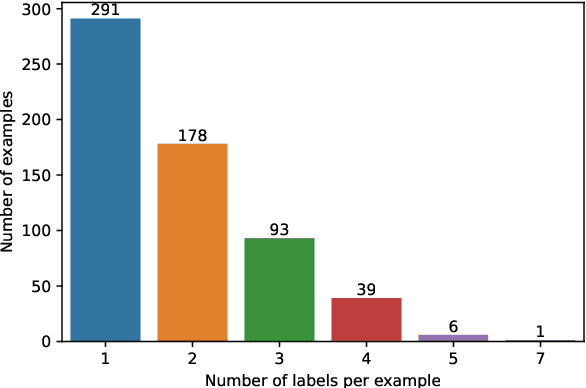
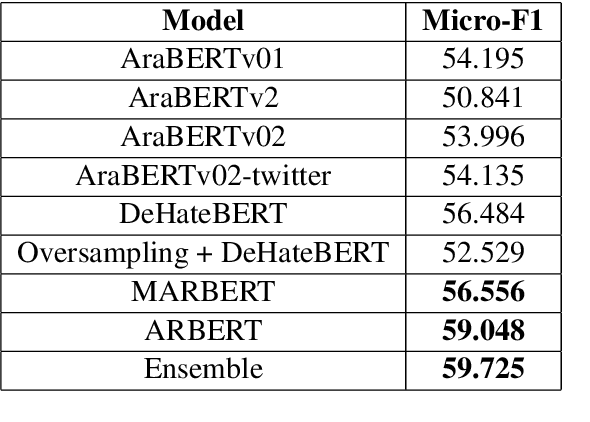
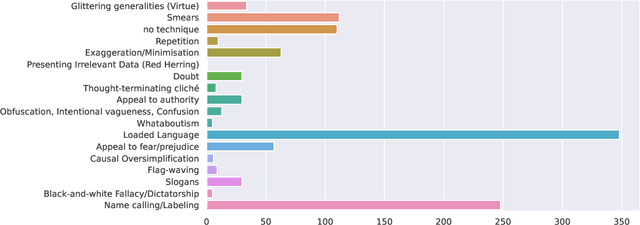
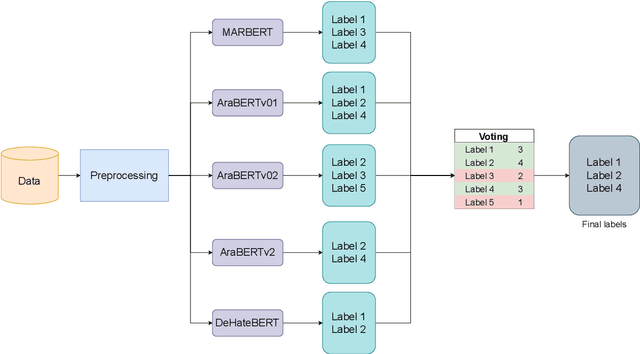
Abstract:The spread of propaganda through the internet has increased drastically over the past years. Lately, propaganda detection has started gaining importance because of the negative impact it has on society. In this work, we describe our approach for the WANLP 2022 shared task which handles the task of propaganda detection in a multi-label setting. The task demands the model to label the given text as having one or more types of propaganda techniques. There are a total of 21 propaganda techniques to be detected. We show that an ensemble of five models performs the best on the task, scoring a micro-F1 score of 59.73%. We also conduct comprehensive ablations and propose various future directions for this work.
Temporal Word Meaning Disambiguation using TimeLMs
Oct 15, 2022
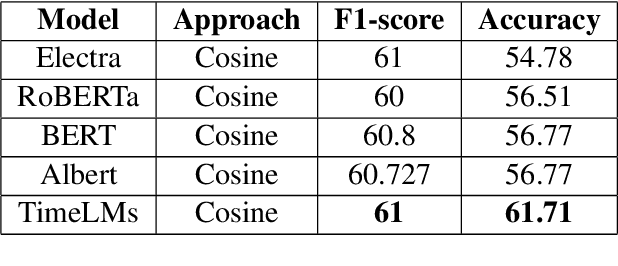
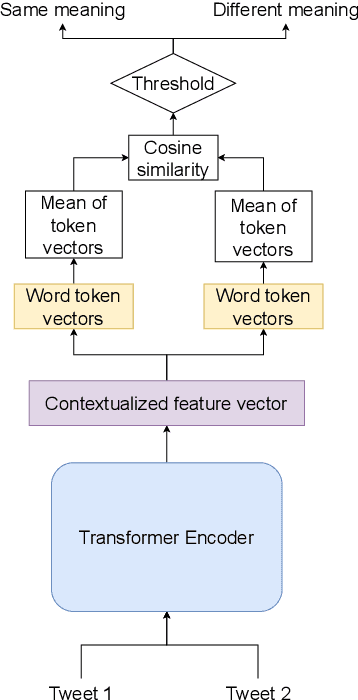
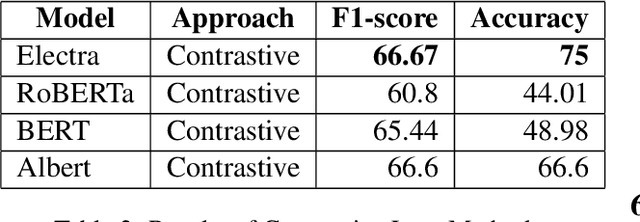
Abstract:Meaning of words constantly changes given the events in modern civilization. Large Language Models use word embeddings, which are often static and thus cannot cope with this semantic change. Thus,it is important to resolve ambiguity in word meanings. This paper is an effort in this direction, where we explore methods for word sense disambiguation for the EvoNLP shared task. We conduct rigorous ablations for two solutions to this problem. We see that an approach using time-aware language models helps this task. Furthermore, we explore possible future directions to this problem.
Spread Love Not Hate: Undermining the Importance of Hateful Pre-training for Hate Speech Detection
Oct 09, 2022

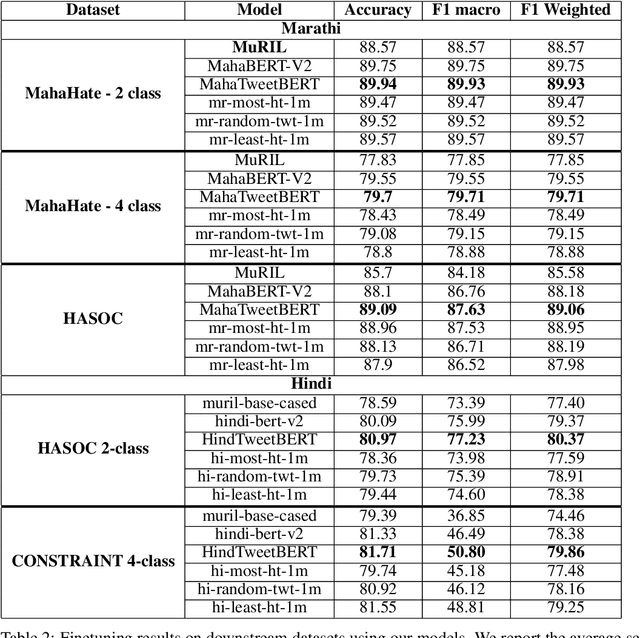
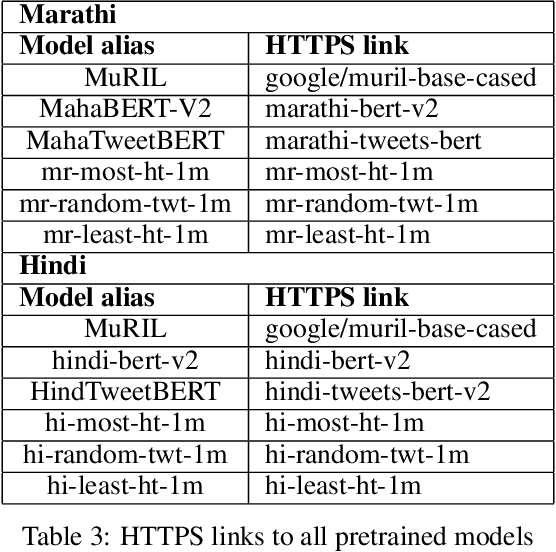
Abstract:Pre-training large neural language models, such as BERT, has led to impressive gains on many natural language processing (NLP) tasks. Although this method has proven to be effective for many domains, it might not always provide desirable benefits. In this paper we study the effects of hateful pre-training on low resource hate speech classification tasks. While previous studies on English language have emphasized its importance, we aim to to augment their observations with some non-obvious insights. We evaluate different variations of tweet based BERT models pre-trained on hateful, non-hateful and mixed subsets of 40M tweet dataset. This evaluation is carried for Indian languages Hindi and Marathi. This paper is an empirical evidence that hateful pre-training is not the best pre-training option for hate speech detection. We show that pre-training on non-hateful text from target domain provides similar or better results. Further, we introduce HindTweetBERT and MahaTweetBERT, the first publicly available BERT models pre-trained on Hindi and Marathi tweets respectively. We show that they provide state-of-the-art performance on hate speech classification tasks. We also release a gold hate speech evaluation benchmark HateEval-Hi and HateEval-Mr consisting of manually labeled 2000 tweets each.
 Add to Chrome
Add to Chrome Add to Firefox
Add to Firefox Add to Edge
Add to Edge